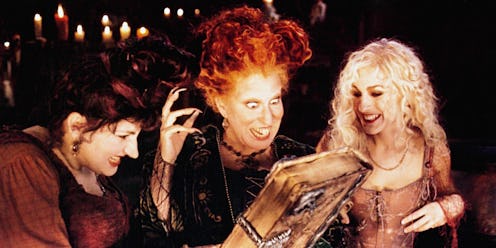Life
A Brief And Spooktacular History Of Halloween

Halloween, much like a fine wine, gets better with age. But when we bust out the candy corn (that we never end up eating), carve all the pumpkins, and rock a killer costume, we should know how the holiday first became a thing. The history of Halloween has deep religious roots, ever-evolving traditions, and we wouldn't have it at all — or any part of America for that matter — without immigrants bringing it here.
Can you imagine how dull autumn would be if we didn't have Halloween? Ugh. No orange and black decor? No terrifying makeup tutorials? NO HOCUS POCUS ? Christmas season would probably kick off on Sept. 1 if we didn't have Halloween to block it. That's just too scary to think about, TBH.
Halloween began as a simple Celtic celebration honoring the end of the harvest season, and has since morphed into an extremely profitable time of year for candy companies. The story of how we got from A to B is important to know, and it's also packed to the gills with fun facts. So here's a brief but spooktacular history of Halloween, because the present and the future are way more fun when you're aware of the past.
Talking to the Dead
Dating back 2,000 years ago, the Celts living in Ireland, England, and France celebrated a festival known as Samhain (pronounced sow-in) that marked the start of the new year on Nov. 1. Samhain marked the end of summer, the harvest season, and the beginning of the cold, dark winter ahead. The Celts believed that the night before the new year began (Oct. 31), the barrier between the living and the dead was at its thinnest, and communication between the two was possible.
Immigrants Brought It To America
Scottish and Irish immigrants are responsible for bringing Samhain, which was later named All Hallows' Eve, to America. The holiday was given an Americanized name "Halloween" and many of the classic Halloween traditions we still practice today came with them. For example, the Irish used to use carved-out turnips with demon faces to keep evil spirits away. Once they immigrated to America, they found turnips to be scarce, so they used pumpkins instead.
The Evolution of Halloween Traditions
Along with the carved pumpkins, bobbing for apples is also a historic tradition. After the Romans conquered Celtic territory, their traditions were melded together. For Samhain, Romans introduced two celebrations in late October. One of them was to honor Pomona — the Roman goddess of fruit and trees. Her symbol is an apple, which connects the tradition of bobbing for apples into original Samhain celebrations.
Around the early 1900s, there was a movement in America to shift the focus of Halloween away from ghouls and witchcraft, and more on community gatherings and fun for children.
It's a Major Money Maker Now
Since many of us splurge on large bags of candy, throw elaborate parties, and spend several weeks planning our Halloween costumes, it's no wonder that Americans drop a serious amount of cash for Halloween each year. According to the National Retail Federation, nine out of 10 Halloween shoppers were expected to buy Halloween candy in 2015, reaching a total of $2.1 billion — and that's just on candy. And the spending on Halloween costumes for 2016 is expected to hit $3.1 billion. What would our ancestors think about that? Something tells me they'd be more surprised that we don't yet have a Hocus Pocus 2.
Image: Walt Disney Pictures; Giphy